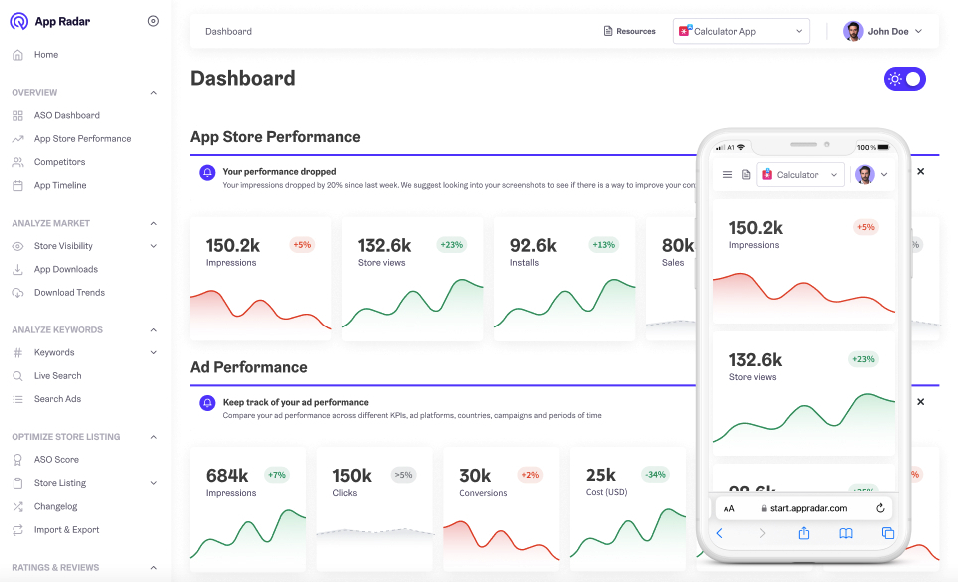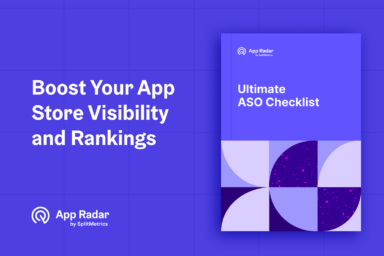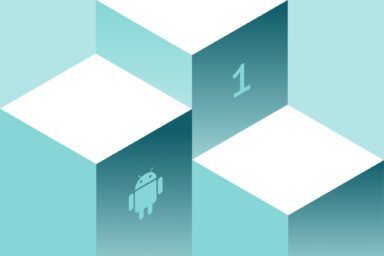8 Steps to Become an ASO Expert in 2024
Want to become an ASO expert, but not sure where to start? This article is the perfect fit.

We’ve compiled our ASO know-how and packed them in 8 actionable steps. Whether you’re launching your own app or trying to get a job in the industry, this article is the starting point for ASO success.
Let’s dive right into it with the first step, the foundation of any successful ASO strategy.
Step 1: Make sure you really understand what ASO is
The first step is understand what app store optimization is. ASO is often misunderstood, so let’s clarify its scope and significance.
ASO is the process of optimizing a mobile app to achieve two primary goals – maximize visibility and boost conversion rates.
Let’s explain both of those:
- Maximizing visibility means enhancing the app’s presence in app stores, both in search results and browsing categories, to drive organic traffic and downloads.
- Boosting Conversion Rates (CVR) is improving the likelihood of users downloading the app, while reducing costs of paid promotions in the process. High CVR positively impacts both organic and non-organic traffic.
You can make it short and simple by saying ASO = traffic + conversion.

The volume and average rating of reviews are major ASO factors. Make sure that the app you’re promoting is free of errors. Ask for ratings at optimal times, such as when users are most engaged.
Step 2: Get Familiar with the App Marketplaces
To master ASO like a pro, you need an in-depth understanding of how different app stores operate.
While the Apple App Store and Google Play Store dominate the market, other platforms like Huawei AppGallery, Microsoft Store, Samsung Galaxy Apps, and Amazon Appstore are gaining traction.

Most developers focus on the App Store and Google Play, but the alternatives are getting more important in the industry (eg. Huawei App Gallery).
It’s important that you understand each store’s unique characteristics to optimize your apps effectively. A common mistake is applying a one-size-fits-all strategy across different stores, we definitely don’t recommend that.
When it comes to search optimization, you should learn how keyword rankings work in both Google Play and the App Store. Learn which fields are indexed and develop strategies for adding and optimizing keywords in your app listings. For explore-based discovery, understand the requirements for making your app visible in various store sections.
While we won’t take a deep dive and jump in the details about the app marketplaces here, but you should definitely read our guides for Google Play Store and Apple App Store.
This resource provides the essential know-how of the two major app marketplaces.
Remember, truly understanding how these stores work requires more than just reading. Experiment with different strategies and analyze the results to gain firsthand experience and insights.
Step 3: Start working on ASO before the app launch
When starting your ASO efforts early, you lay the groundwork for a successful app launch, and make sure your app stands out in a crowded marketplace.
Keyword Research and Content Preparation
Start by conducting comprehensive keyword research. Identify the terms and phrases that potential users are likely to search for. Begin crafting the content for your app listing, including titles, descriptions, and metadata.

Having a well-optimized product page ready from day one significantly increases your chances of achieving high visibility and downloads immediately after launch.
App page optimization
Optimize your app’s product page before the app hits the marketplace. The goal here is to set a solid foundation for your app marketing strategy. This proactive approach ensures that your app is well-positioned to attract organic traffic and achieve higher conversion rates from the outset.
Practical ASO checklist for pre-app launch
To ensure a smooth launch, follow this checklist of essential tasks to complete before your app goes live:
- Research Keywords – Use tools like App Radar to find relevant keywords.
- Analyze Competitors – Look at top apps in your category to see how they optimize their listings. We’ll talk more about this part later on.
- Prepare Content – Write and refine your app’s title, description, and other metadata.
- Monitor Trends – Keep an eye on industry trends and adjust your strategy accordingly.

Step 4: Launch your app and start tracking ASO KPIs
The best way to truly understand ASO is to launch a mobile app or game on the stores you aim to master. This hands-on experience will get you familiar with the developer consoles (Google Play Console and App Store Connect).
Launching the app from zero will enable you to go through all the steps one by one and get to know each store, their similarities, specificities, and differences.
Remember, the only way to master ASO is through practical application. If you need help with launching your app on Google Play Console or App Store Connect, check out our detailed guides.
Once your app is live and available for download, it’s time to start tracking the key performance indicators (KPIs) that will help you measure your ASO success.
Here are some essential KPIs to monitor:
Visibility Metrics
- Keyword Rankings: Track your app’s position in search results for target keywords.
- Top Charts Rankings: Monitor your app’s ranking in the top charts (free, paid, grossing).
- Category Rankings: Check how your app ranks within its specific category.
- Impressions: Measure how often your app is viewed in the store.
Conversion Metrics
- Click-Through Rate (CTR): The percentage of users who click on your app listing after seeing it.
- Conversion Rate (CR): The percentage of users who download your app after visiting the product page.
- User Reviews and Ratings: Monitor the volume and average rating of user reviews.
Retention Metrics
- User Engagement: Track metrics like session duration and the number of sessions per user.
- Retention Rate: The percentage of users who continue to use your app over time.
- Churn Rate: The percentage of users who stop using your app after a certain period.
Growth Metrics
- Download Rate: The number of downloads your app receives over time.
- Active Users: The number of users actively using your app.
Monetization Metrics
- Revenue: Total revenue generated from in-app purchases, ads, and subscriptions.
- Average Revenue Per User (ARPU): The average revenue generated per user.
Step 5: Be creative and experiment
To become a true ASO rockstar, you must break free from boundaries and embrace creativity. The best way to discover what works and what doesn’t is to experiment with different strategies.
Don’t be afraid of failure; failing is key to learning.
A/B testing, creative testing and content variations
Regularly conduct A/B tests to compare different versions of your app’s store listing. This iterative process helps identify which elements—such as icons, screenshots, videos, titles, and descriptions—improve visibility and conversion rates.
You can also test various creative assets like app icons, screenshots, and videos. For instance, changing the background color of your screenshots or the style of your app icon can significantly impact user engagement and conversion rates.
Don’t be afraid to experiment with different app descriptions and promotional texts to see which versions resonate best with your audience.
Carefully track the outcomes of your experiments. Use tools to measure key metrics such as conversion rates, click-through rates, and user engagement.
PRO TIP: ASO is a dynamic field that constantly evolves. What works today might not work tomorrow – stay adaptable and keep experimenting. Regularly update your strategies based on the latest trends and user behaviors.
Step 6: Study your competitors
You can learn a lot from your competitors. Start with keeping an eye (or two) on them. When you’re analyzing the market your app will observe how the competitors optimize their listings, the changes they implement, and the frequency of these updates.
Monitor their KPIs (eg. app download growth, app page kw rankings) with App Radar to better understand the impact of their strategies.
You can also analyze the keywords your competitors are targeting and ranking for, and study their user reviews to understand what users like and dislike. Conduct A/B tests to observe the effectiveness of different strategies.
PRO TIP: Understanding your competitors’ approaches helps you refine your own ASO strategy that keeps you ahead in the competitive app marketplace.
Step 7: Always stay up to date
ASO is very often described as an ever-changing matter, and for a reason. Keep on learning new ASO tricks, reading about ASO trends, experiment with new strategies, and always adapt to changes in the app stores.
Proactivity goes a long way in ASO.
Always follow industry experts and (if you can) participate in conferences to gain insights into the latest trends and best practices.

Events like App Growth Week by SplitMetrics and the App Promotion Summit offer valuable opportunities to learn from leading professionals and network with peers. These events ge you in front of cutting-edge knowhow that helps you stay ahead of the curve.
Step 8: Work in team & learn from others
You will not become an ASO master by working on your own. Yes, you can learn a lot from all the resources I mentioned in the former point, but nothing compares to the experience of working with a team and learning from others.
Collaborating with colleagues allows you to challenge each other, share insights, and leverage each other’s strengths and specialties. This exchange of knowledge and experience drives your growth and development as a mobile growth expert.
Summing up the 8 tips to become an ASO expert
Becoming an ASO expert requires a blend of understanding the fundamentals, early preparation, and continuous learning.
Launch your app with a well-optimized product page, track key performance indicators, and embrace creativity through experimentation.
Learn how to use and leverage reliable ASO tools. These tools offer comprehensive features like keyword research, competitor analysis, and performance tracking, which are essential for optimizing your app effectively.
App Radar, for instance, provides detailed keyword data, AI-driven insights, and the ability to manage store listings directly from the platform.
Stay informed about industry trends, study your competitors, and collaborate with a team to share insights and grow together.
Latest Posts


